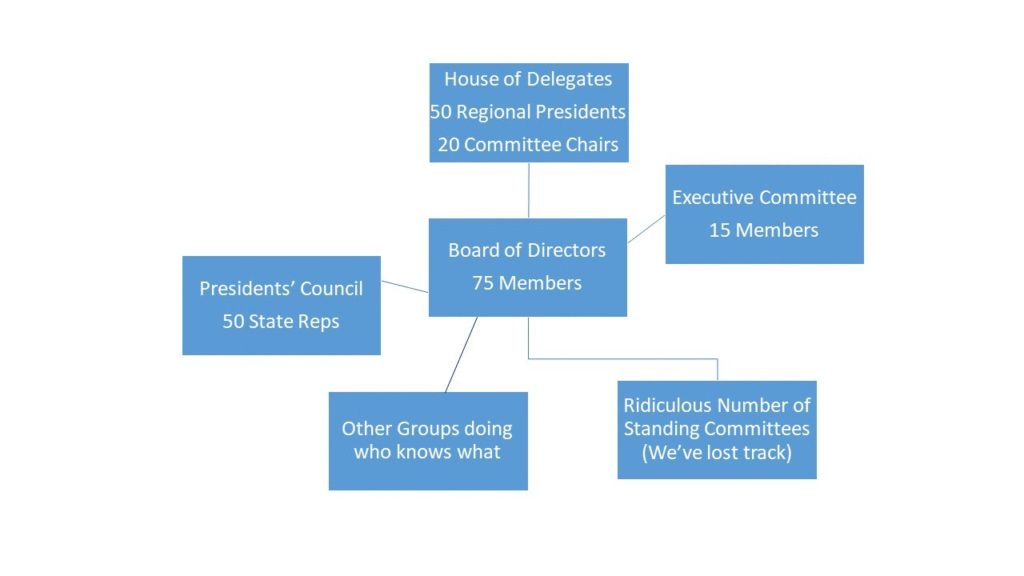There are great books on governance that tell big boards to downsize; shift to competency-based, rather than constituency or geography-based selection system; be nimble, responsive and strategic; and select the best people for the job, not just those who “worked their way through the positions and did their time.” These aren’t radical ideas; they’ve become mainstream.
All great stuff that makes a lot of sense, and it works. With that in mind, you’d think association boards everywhere would jump on the bandwagon and get rid of their arcane, bloated, inefficient structures and adopt these “best practices.” But most don’t.
Many try and give up. Most don’t even try. A few actually do it – usually yielding positive results. So, if it makes logical sense and yields positive results, why can’t associations just “git ‘er done?”
What makes restructuring hard is not restructuring. Restructuring is actually pretty easy. It’s not hard to look at an association’s governance structure and say, “Wow, that’s nuts.” And it’s pretty easy to say, “We could get a lot more done, faster, if we eliminated these volunteer positions, which are inert placeholders with no meaningful roles.”
The changes needed are usually logical and fairly obvious. The challenge is those inert placeholders are people. And even if they know in their hearts they aren’t doing much in service to the organization, people never act rationally in the face of loss. They react emotionally and use logic to rationalize their emotions, rather than vice versa. They feel the need to protect and defend their positions.
Have you ever moved a box you never open from one house to another (and another), storing it in the basement each time? Ownership does a strange thing to human psychology. The fear of loss gives greater value to an object that rationally should have little or no value, like a mystery box in the basement.
I’ve yet to meet anyone who can make a factual (not emotional or opinion-based) case for the benefits of having a huge House of Delegates or a 50+ member board of directors. Or that having board positions based on geography or constituency actually ensures “everyone has a voice” rather than the reality I’ve witnessed, which is a fractured board where members wrongly believe their fiduciary responsibility is to represent their constituency’s interests vs. the best interests of the entire organization.
When it comes to association governance structures, organizational culture can be so hard to overcome that many leaders simply capitulate rather than fight a losing battle, even if they know the change is in the organization’s best interest. They’d rather stick to tangible operational wins and call it a day.
The Boilerplate Theory (Or Why Governance Restructure Shouldn’t Be So Hard)
Particularly in large organizations that are upwards of 50 years old, governance structure is rarely truly challenged. Volunteers suffer under the delusion that the structure – no matter how convoluted and inefficient – is sacrosanct and, like those who drew up the US Constitution, your organization’s founders were deliberate and thoughtful when they put together the structure decades ago.
And maybe they were. But I doubt it.
I’ve started a few organizations myself, and I created bylaws using boilerplate documents from similar organizations, substituting our name via search and replace.
My guess is, that’s what most founders do. They don’t spend a lot of time ruminating about how best to structure and govern an organization at the beginning. They’re more interested in doing the work that the organization was created to do; creating governing documents and structures is just a necessary evil.
So it is probable to me that most organizations simply looked to similar organizations and the “best practices” of the time (i.e., what everyone else was doing) when they created their governance structures. Once in place, successive volunteer and staff leaders simply followed the template, never questioning it.
While I haven’t done an official scientific study, there’s something I’ve noticed from experienced observation. The majority of medical societies I’ve encountered have virtually identical governance structures. Nearly all trucking industry associations, national and state-level, have virtually the same governance structures. And I’d venture to guess I’d find that to be true in other industries.
But while within the industries the structures are identical, trucking association structures look nothing like the medical society structures. Why? My theory is someone set the standard in the industry early on and everyone else copied it. I call this The Boilerplate Theory.
If I’m right, the vast majority of unexamined governance structures aren’t based on “best practices.” They’re just a best guess at a way to organize an organization according to whoever created them at the time. They’re no different than an office organizational chart created by management. And, just as there are a million ways to structure a business – from “flat” to “matrix” to “hierarchical” – there are a million ways to structure an association.
Why would one governance structure work for doctors but not engineers, or for truckers but not pilots?
The obvious answer is, the legacy structures organizations have today have nothing to do with what is “best” for who they represent. They simply represent the thinking of whoever the founders were. Nevertheless, if you try to change the structure of any of these organizations, you will find members passionately defending the status quo and questioning why you would even consider it.
Wouldn’t it make more sense to assume the founders probably saw putting together governing documents as a necessary evil and were more passionate about the mission than the structure? And even if they were thoughtful about their design, times change. The societal and volunteer environment in, say, the 1940’s, was whole lot different than today.
If we could get our members to put governance structures in that perspective, we might have some chance of avoiding the absurd lengths leaders must go to make changes.
Folks, legacy governance structures are mostly boilerplate organizational charts, not thoughtful designs. Let go of the mystery box in the basement.
Connect with Jeff on LinkedIn: https://www.linkedin.com/pulse/why-association-governance-restructure-so-hard-heres-jeff/


